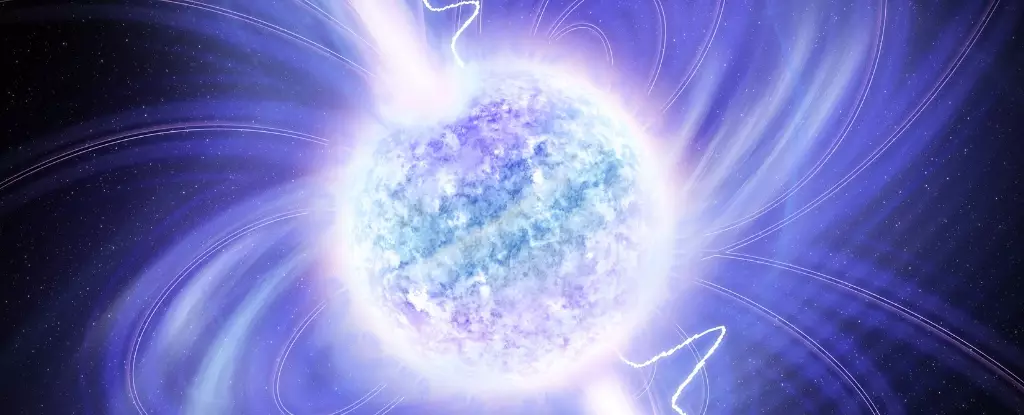Pulsars have long captivated astronomers and astrophysicists, likened to celestial lighthouses due to their pulsating beams of radio waves that sweep across the cosmos. These star remnants, typically spinning at extraordinary rates, have been primarily understood through the principles of neutron star physics. However, recent observations have unveiled an unprecedented anomaly; ASKAP J1839-0756, a pulsar that challenges the very foundation of our comprehension. This slow-rotating cosmic entity spins once every 6.5 hours, a tempo that forces astrophysicists to reevaluate existing theories about neutron stars and their magnetic properties.
Traditionally, the emission of radio pulses from pulsars results from their rapid rotation, which converts rotational energy into electromagnetic radiation. Most known pulsars rotate in seconds, and as they age, they gradually lose energy and slow down—eventually leading to the cessation of their radio emissions. This decay process has set a theoretical boundary, suggesting that once a neutron star’s spinning rate dips below a minute, it becomes inert regarding pulse generation.
Yet, the existence of ASKAP J1839-0756 contradicts this long held view. This pulsar is emitting periodic radio waves while rotating at a leisurely pace, which is not only unexpected but fundamentally perplexing. This suggests that the astrophysical processes at play in neutron stars may be much more nuanced than previously believed, opening the door to novel theoretical frameworks.
The discovery of ASKAP J1839-0756 originated from observations made using the Australia Square Kilometre Array Pathfinder (ASKAP) telescope. Positioned in Wajarri Yamaji country, Western Australia, the telescope initially detected a mysterious object only because its radio emissions were distinctly atypical—those emissions decreased dramatically within a brief 15 minutes. What began as a single, bright burst turned into a recurrent pulse with intervals of 6.5 hours. This discovery was not made in isolation; it required follow-up observations using several astrological instruments, including the Australia Telescope Compact Array and the MeerKAT radio telescope in South Africa, confirming its periodic behavior.
Interestingly, a peculiar characteristic of ASKAP J1839-0756 is its alignment with Earth, allowing astronomers to observe emissions from both magnetic poles. For standard pulsars, this alignment is rare. Indeed, pulsars typically resemble one-sided beacons where only one of the poles is visible from our vantage point on Earth.
The primary question centers around the mechanism powering ASKAP J1839-0756. One hypothesis is that it may be a magnetar—a type of neutron star characterized by an extremely strong magnetic field. Magnetars can generate radio emissions through distinct processes than standard neutron stars, which could explain the pulsar’s slower rotation. Yet, even magnetars are generally associated with spin rates of seconds rather than hours, making ASKAP J1839-0756 unique even within that class.
Another intriguing angle posits that ASKAP J1839-0756 might be a white dwarf, despite the fact that such stars have not been observed to emit radio pulses. With the current lack of evidence confirming a white dwarf’s presence in this location, skepticism remains.
The existence of ASKAP J1839-0756 represents a significant deviation from established astrophysical models. Its slow rotation and the observed interpulses challenge scientists not only to revisit the characterization of neutron stars but also to analyze what this object might mean for broader cosmic phenomena. The eerie flickering from both magnetic poles can offer unique insights into the magnetic field alignment of neutron stars as they age—a puzzle that scientists have yet to fully solve.
Additionally, the finding reinforces the notion that the universe is filled with anomalies that do not conform to our expectations. ASKAP J1839-0756 serves as a reminder of the complexities within stellar evolution and the myriad of unknowns that continue to present themselves as astronomy progresses.
As researchers continue studying ASKAP J1839-0756, it will afford them the opportunity to probe deeper into the complexities of stellar physics and magnetic field interactions. The unexpected characteristics of this slow-moving pulsar will likely prompt fresh investigations into cosmic phenomena, reminding the scientific community of the universe’s capacity to confound our understanding, even in an age where knowledge seems vast. The excitement surrounding this pulsar illustrates the enduring mystery of space, ensuring that curiosity, inquiry, and exploration remain central to the scientific endeavor.


Leave a Reply